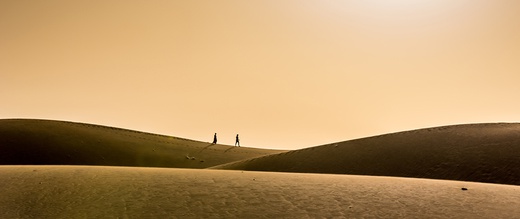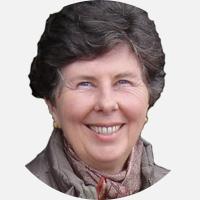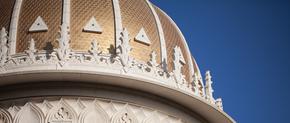The views expressed in our content reflect individual perspectives and do not represent the authoritative views of the Baha'i Faith.
Abraham was now “old, and well stricken in age.” His sons were married, and grandchildren were beginning to arrive.
His wife, Sarah, had died, as had his concubine, Hagar. It was a time to ease up a bit and bask in the sun—or at least that would be the usual way of things if Abraham were a usual man. But he wasn’t, so he opened a new chapter of his life on Earth by marrying Keturah and fathering six sons with her.
The name Keturah, which can also be spelled Katurah, Cetura, or Qeturah, means perfume or sweet-smelling incense. Very little is known about her, except for a single suggestion that she was the daughter of two of Abraham’s household servants, people who might originally have been from either Ur or Harran.
Among the many questions people have about Keturah are whether she was a wife or a concubine, and whether she and Abraham were united while Sarah was still alive or after she died.
The New Testament mentions Keturah as a concubine, but the Old Testament and the Baha’i writings agree in describing her as a wife. Although the sequence of Abraham’s life as outlined in Genesis indicates that he and Keturah married after Sarah’s death, that particular sequence may have more to do with the needs of laying out the story in an easy-to-follow form than with the actual order of events. It is quite possible that the union took place while Sarah was alive, but, even so, Keturah could still have been a true wife. As the Old Testament indicates time and time again, taking more than one wife—plus a cluster of concubines—was a common and accepted practice during that period.
But, wife or concubine, the most significant bit of information about their union is that Keturah subsequently bore six sons, giving Abraham a grand total of eight male children. All of Abraham’s offspring would be blessed by God, and these six were indisputably part of the family. In order that the genealogy might be remembered and traced over the centuries, Genesis records it this way:
And she bare him Zimran, and Jokshan, and Medan, and Midian, and Ishbak, and Shuah.” One of the six—Midian—receives the honor of having his children named: “Ephah, and Epher, and Hanoch, and Abidah, and Eldaah.” Another—Jokshan—receives even more attention by having both children and grandchildren listed: “And Jokshan begat Sheba, and Dedan. And the sons of Dedan were Asshurim, and Letushim, and Leummim. – Genesis 25:2-4.
After the six sons had been born, Abraham gave Keturah and the children gifts and, in the succinct but not-very-informative words of Genesis, sent them “eastward, unto to the east country.” Abraham was nearing the end of his life, and he obviously knew that the destiny of this group of children lay not in Canaan but elsewhere. If, as suggested by the Book of Jubilees, Keturah’s parents were originally from Ur of the Chaldees (which certainly can be described as the east country) she would have had tribal relatives there who would be happy to see her and delighted to meet her children.
The most common notion about what the sons did after leaving Canaan is that they and their descendants became involved in trading spices, silks, gems, and other goods. Midian moved northeast of Canaan—to the upper part of Arabia near the gulf of Aqaba—and is credited with founding the Midianite tribe. Muhammad mentions Midian several times in the Qur’an as Madyan and refers to the Midianite tribe as the Madyan people. One of Midian’s descendants, Jethro, makes an appearance in both Islam and Judaism. In the Qur’an, Jethro is called Shu’aib and is acclaimed as a prophet who was rejected by the other members of the Midianite/Madyan tribe. In Judaism, Jethro is chiefly remembered as having been the father-in-law of Moses, something that occurred when Moses fled to Midian from Egypt and married Zipporah, who was one of Jethro’s seven daughters. Zipporah was later instrumental in saving Moses’ life, an incident that underlines the importance of Keturah’s descendants.
Jokshan (the second son of Keturah and the father of Sheba and Dedan), is also thought to have settled in Arabia, somewhere along the western coast. This supposition is based primarily on the way that the names of his children correspond with Arabian geography. Sheba was a kingdom in southern Arabia, and Dedan (currently called “Al ‘ula”) was an oasis along an ancient path that connected southwestern Arabia to Canaan and the Mediterranean. With the passing of centuries, the amount of traffic on the path increased (a single caravan might contain two thousand camels), and Dedan grew into a city. The path eventually became known as the “incense road” because the most prized products carried along it were aromatic nuggets of dried sap harvested from frankincense and myrrh trees growing in southern Arabia. The way that Keturah’s name—incense—was applied to the route along which most of her sons settled is an intriguing congruence:
This is the springtime of manifestation. The vernal shower has descended from the cloud of divine mercy; the life-giving breeze of the Holy Spirit is wafting the perfume of blossoms. From field and meadow rises a fragrant breath of thanksgiving like pure incense ascending to the throne of God. – Abdu’l-Baha, The Promulgation of Universal Peace, p. 210.
Zimran, too, is said to have settled in Arabia, but farther to the south than either Midian or Jokshan. His name has been linked with the town of Zabran, which once lay between Mecca and Medina. Various cuneiform texts connect Shuah, the youngest son of Keturah and Abraham, with Syria. They place him in the land that was known as Sûchu or Suhi, an area that lies along the northern part of the Euphrates river. The idea that Shuah succeeded in founding a tribe/kingdom bearing his name is reinforced by the book of Job in the Old Testament because several verses describe Job—who lived several hundred years after Shuah—as having a friend who was a Shuhite.
Shuah’s slightly older brother, Ishbak, probably lived to the north of Shuah and founded a tribe of his own. Old Assyrian records affirm this by listing one of the northern Syrian tribes as “Iasbuq.” Although I have suggested specific places where Keturah’s sons settled, it is far more likely that the process by which they and their descendants moved to the east and became credited with being progenitors of tribes was a gradual one that extended over several generations.
The most mysterious of Keturah’s sons is Medan, the third to be born. None of the sacred scriptures shed light on where he settled, but there have been suggestions that he lived southeast of Midian. There is also a very tenuous connection between his descendants (and/or the descendants of Midian) and the marsh dwellers of Mesopotamia—the same marsh that surrounded Ur when Abraham lived there—because the marsh dwellers are currently known as the Medan people (also Ma’dãn or Mi’dan). Those who connect the marsh dwellers to Medan think that people from his tribe fled to the marshes and settled there to escape being killed during one of the many wars that swept across Syria and northern Iraq.
Wherever Keturah’s children really settled, the manner in which Abraham deliberately scattered six of his eight sons and their “gifts” along trade routes connecting three continents (Africa, Europe, and Asia) is charmingly symbolic. More than any other single event, the act of sharing so many sons with the larger world outside Canaan indicated that God’s magnificent promise to Abraham really was meant to come true:
I will make your descendants as the dust of the earth; so that if a man can number the dust of the earth, then shall thy seed also be numbered. – Genesis 13:16.

















Comments
Sign in or create an account
Continue with Facebookor